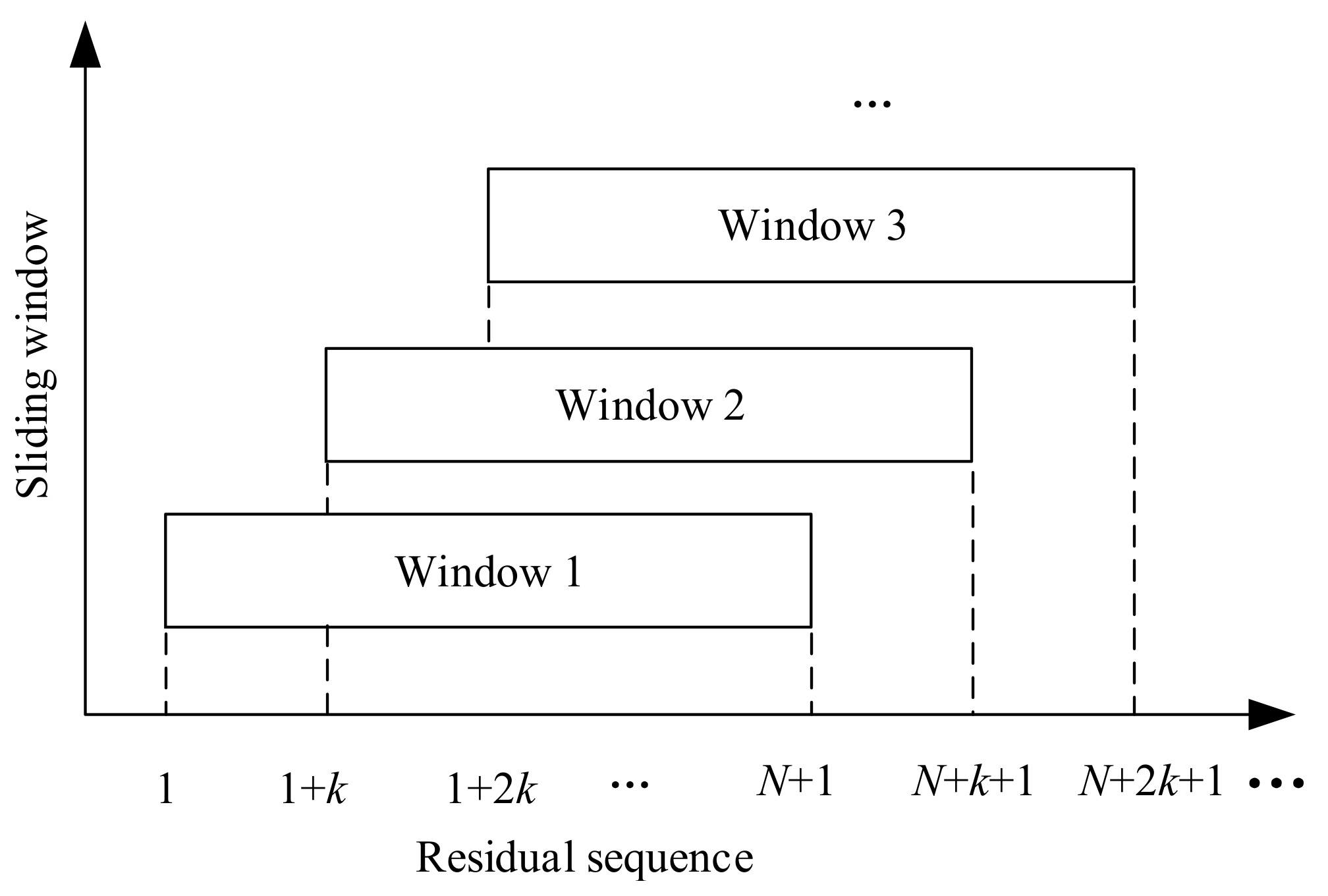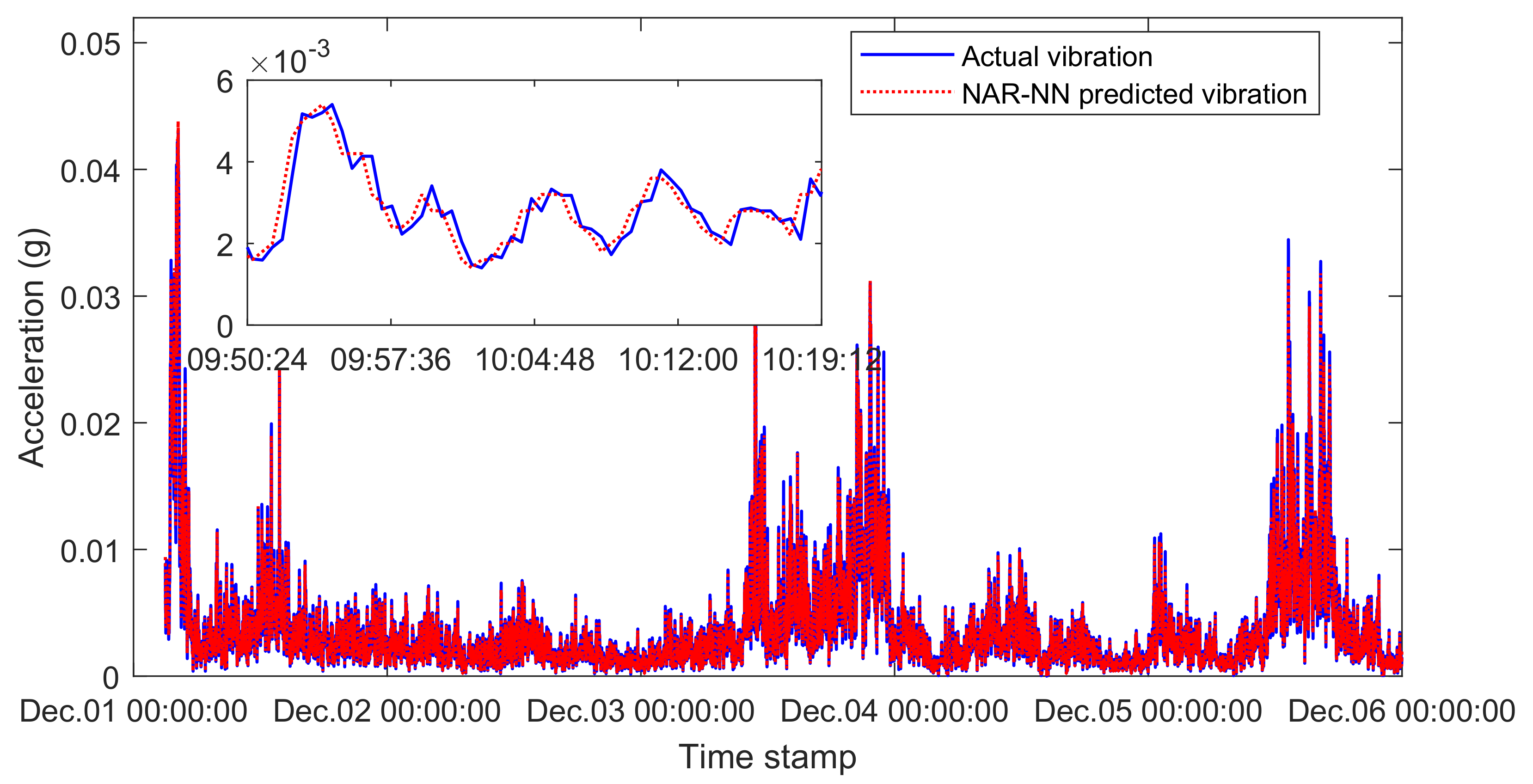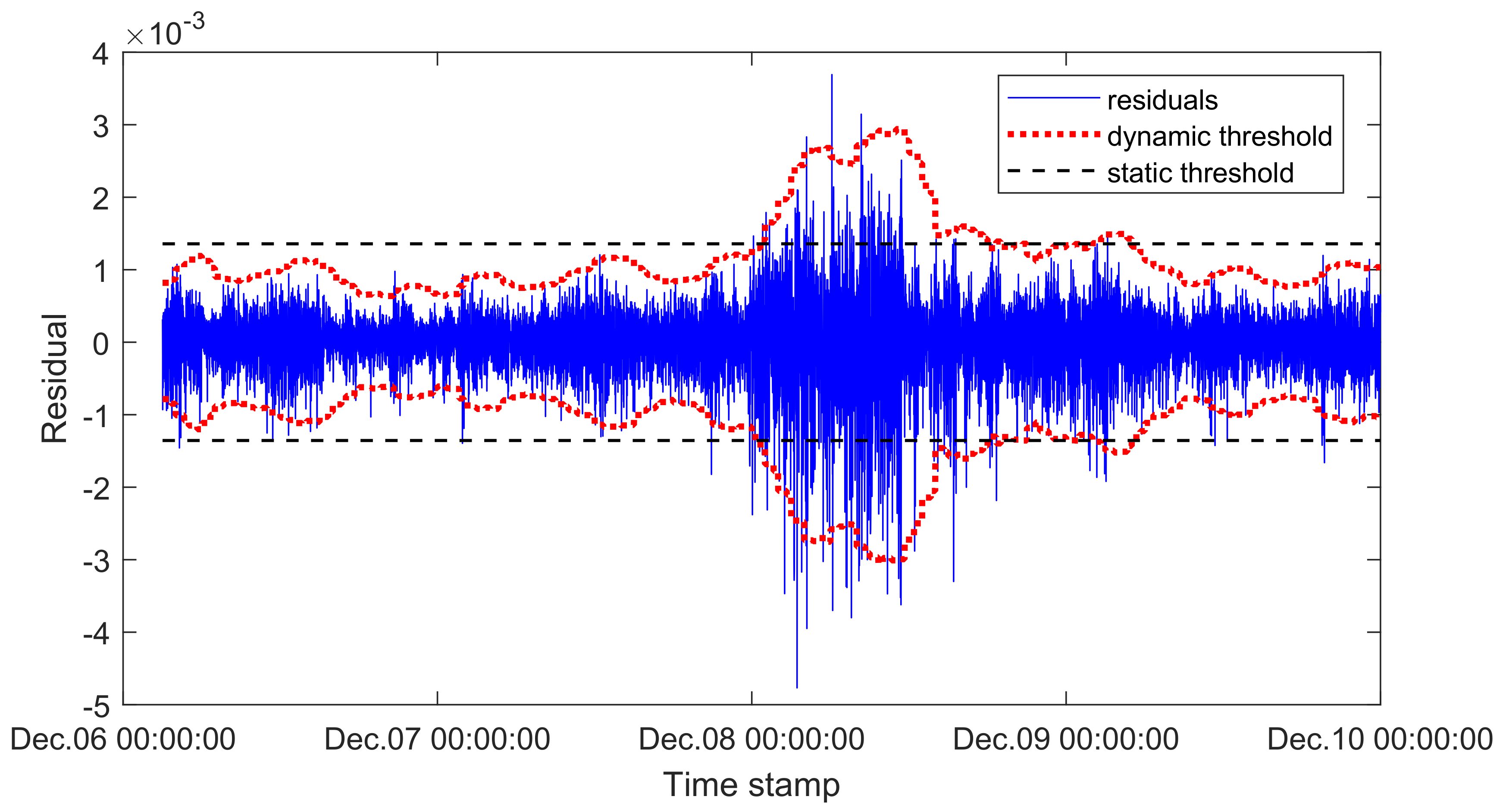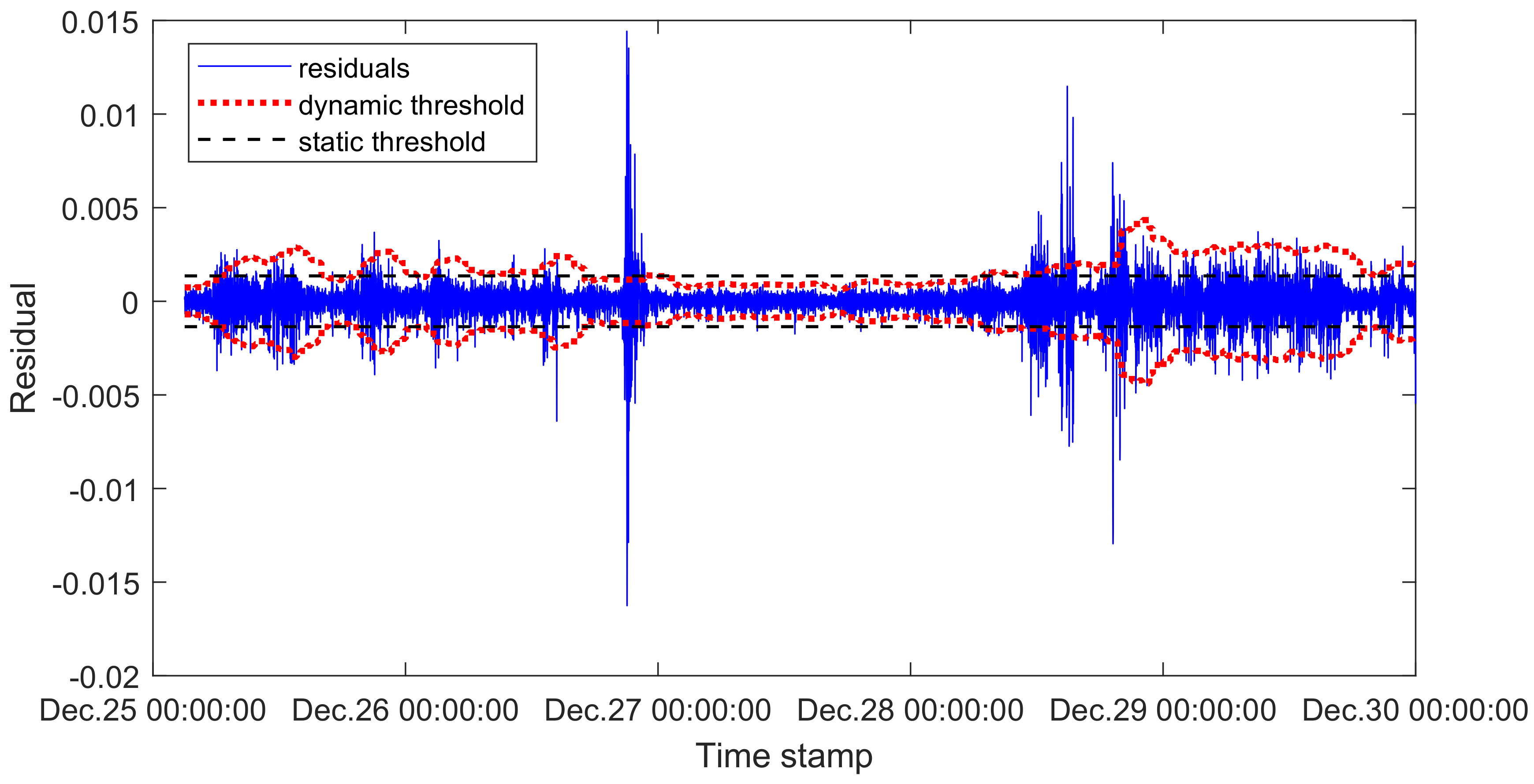Monitoring Wind Turbine Gearbox with Echo State Network Modeling and Dynamic Threshold Using SCADA Vibration Data
Abstract
:1. Introduction
- (1)
- A vibration normal behavior model is built based on the ESN algorithm to capture the nonlinear correlations and temporal dynamics between the inputs and outputs, which can well describe the vibration normal behavior of wind turbine gearboxes. To our best knowledge, this is the first application of the ESN in the field of wind turbine health monitoring and fault detection.
- (2)
- A dynamic threshold monitoring scheme with the sliding window technique is designed to update the residual monitoring threshold in real time, and then an anomaly ratio indicator is defined to further reduce the false alarms.
- (3)
- SCADA vibration data from a wind turbine gearbox in a real wind farm is used to evaluate the performance of the proposed method. Compared with the traditional static threshold monitoring method, the proposed method achieved more reliable monitoring performance with no or fewer false alarms.
2. Wind Turbine Gearbox Monitoring and SCADA Vibration Data Description
3. Proposed Health Monitoring Framework for Wind Turbine Gearboxes
3.1. Overview of the Proposed Framework
- (1)
- Offline modeling phase: Normal vibration data are first selected from historical SCADA data for normal behavior modeling. To eliminate the effect of noise on prediction performance, some necessary processing steps, including data smoothing will be adopted. Then, the preprocessed data are reconstructed to determine the input and output variables required for modeling. Then, the ESN algorithm is used to capture the normal vibration behaviors of the gearbox. Finally, in order to detect the abnormal behavior of the gearbox effectively, an abnormal ratio indicator is calculated based on residuals and then an alarm threshold is determined for subsequent fault detection and warning.
- (2)
- Online monitoring phase: The online monitored vibration data is first preprocessed using the same preprocessing steps described in the offline modeling phase, and then input to the well trained ESN-based normal behavior model to produce the predicted outputs and the corresponding residuals. Next, the residuals are analyzed step by step using the sliding window technique to dynamically update the threshold. Furthermore, an abnormal ratio indicator within a certain time period is calculated for fault detection. If the abnormal ratio exceeds the predefined alarm threshold , a failure warning signal will be issued.
3.2. Vibration Normal Behavior Modeling with ESN
3.3. Dynamic Threshold Monitoring Scheme
4. Case Study
4.1. Model Development and Validation
4.2. Model Testing
5. Conclusions
Author Contributions
Acknowledgments
Conflicts of Interest
References
- Tchakoua, P.; Wamkeue, R.; Ouhrouche, M.; Slaoui-Hasnaoui, F.; Tameghe, T.A.; Ekemb, G. Wind turbine condition monitoring: State-of-the-art review, new trends, and future challenges. Energies 2014, 7, 2595–2630. [Google Scholar] [CrossRef]
- Fitzgerald, B.; Basu, B. A monitoring system for wind turbines subjected to combined seismic and turbulent aerodynamic loads. Struct. Monit. Maint. 2017, 4, 175–194. [Google Scholar]
- Liu, W.; Tang, B.; Han, J.; Lu, X.; Hu, N.; He, Z. The structure healthy condition monitoring and fault diagnosis methods in wind turbines: A review. Renew. Sustain. Energy Rev. 2015, 44, 466–472. [Google Scholar] [CrossRef]
- Qiao, W.; Lu, D. A Survey on Wind Turbine Condition Monitoring and Fault Diagnosis—Part I: Components and Subsystems. IEEE Trans. Ind. Electron. 2015, 62, 6536–6545. [Google Scholar] [CrossRef]
- Feng, Y.; Qiu, Y.; Crabtree, C.J.; Long, H.; Tavner, P.J. Monitoring wind turbine gearboxes. Wind Energy 2013, 16, 728–740. [Google Scholar] [CrossRef]
- Hossain, M.L.; Abu-Siada, A.; Muyeen, S. Methods for Advanced Wind Turbine Condition Monitoring and Early Diagnosis: A Literature Review. Energies 2018, 11, 1309. [Google Scholar] [CrossRef]
- Jiang, G.; He, H.; Xie, P.; Tang, Y. Stacked multilevel-denoising autoencoders: A new representation learning approach for wind turbine gearbox fault diagnosis. IEEE Trans. Instrum. Meas. 2017, 66, 2391–2402. [Google Scholar] [CrossRef]
- Teng, W.; Zhang, X.; Liu, Y.; Kusiak, A.; Ma, Z. Prognosis of the remaining useful life of bearings in a wind turbine gearbox. Energies 2016, 10, 32. [Google Scholar] [CrossRef]
- Igba, J.; Alemzadeh, K.; Durugbo, C.; Eiriksson, E.T. Analysing RMS and peak values of vibration signals for condition monitoring of wind turbine gearboxes. Renew. Energy 2016, 91, 90–106. [Google Scholar] [CrossRef] [Green Version]
- Coronado, D.; Wenske, J. Monitoring the Oil of Wind-Turbine Gearboxes: Main Degradation Indicators and Detection Methods. Machines 2018, 6, 25. [Google Scholar] [CrossRef]
- Gómez Muñoz, C.Q.; García Márquez, F.P. A new fault location approach for acoustic emission techniques in wind turbines. Energies 2016, 9, 40. [Google Scholar] [CrossRef]
- Zhang, Y.; Lu, W.; Chu, F. Planet gear fault localization for wind turbine gearbox using acoustic emission signals. Renew. Energy 2017, 109, 449–460. [Google Scholar] [CrossRef]
- Lu, D.; Qiao, W.; Gong, X. Current-based gear fault detection for wind turbine gearboxes. IEEE Trans. Sustain. Energy 2017, 8, 1453–1462. [Google Scholar] [CrossRef]
- Kusiak, A.; Li, W. The prediction and diagnosis of wind turbine faults. Renew. Energy 2011, 36, 16–23. [Google Scholar] [CrossRef]
- Yang, W.; Court, R.; Jiang, J. Wind turbine condition monitoring by the approach of SCADA data analysis. Renew. Energy 2013, 53, 365–376. [Google Scholar] [CrossRef]
- Guo, P.; Infield, D.; Yang, X. Wind Turbine Generator Condition-Monitoring Using Temperature Trend Analysis. IEEE Trans. Sustain. Energy 2012, 3, 124–133. [Google Scholar] [CrossRef]
- Guo, P.; Bai, N. Wind turbine gearbox condition monitoring with AAKR and moving window statistic methods. Energies 2011, 4, 2077–2093. [Google Scholar] [CrossRef]
- Yang, H.H.; Huang, M.L.; Yang, S.W. Integrating Auto-Associative Neural Networks with Hotelling T2 Control Charts for Wind Turbine Fault Detection. Energies 2015, 8, 12100–12115. [Google Scholar] [CrossRef] [Green Version]
- Bangalore, P.; Tjernberg, L.B. An Artificial Neural Network Approach for Early Fault Detection of Gearbox Bearings. IEEE Trans. Smart Grid 2015, 6, 980–987. [Google Scholar] [CrossRef]
- Bangalore, P.; Letzgus, S.; Karlsson, D.; Patriksson, M. An artificial neural network-based condition monitoring method for wind turbines, with application to the monitoring of the gearbox. Wind Energy 2017, 20, 1421–1438. [Google Scholar] [CrossRef]
- Vidal, Y.; Pozo, F.; Tutivén, C. Wind Turbine Multi-Fault Detection and Classification Based on SCADA Data. Energies 2018, 11, 3018. [Google Scholar] [CrossRef]
- Yang, C.; Liu, J.; Zeng, Y.; Xie, G. Real-time condition monitoring and fault detection of components based on machine-learning reconstruction model. Renew. Energy 2019, 133, 433–441. [Google Scholar] [CrossRef]
- Wang, L.; Zhang, Z.; Long, H.; Xu, J.; Liu, R. Wind turbine gearbox failure identification with deep neural networks. IEEE Trans. Ind. Inform. 2017, 13, 1360–1368. [Google Scholar] [CrossRef]
- Jiang, G.; Xie, P.; He, H.; Yan, J. Wind turbine fault detection using a denoising autoencoder with temporal information. IEEE/ASME Trans. Mechatron. 2018, 23, 89–100. [Google Scholar] [CrossRef]
- Jaeger, H. The “echo state” Approach to Analysing and Training Recurrent Neural Networks-with an Erratum Note; Technical Report; German National Research Center for Information Technology (GMD): Bonn, Germany, 2001; Volume 148, p. 13. [Google Scholar]
- Jaeger, H.; Haas, H. Harnessing nonlinearity: Predicting chaotic systems and saving energy in wireless communication. Science 2004, 304, 78–80. [Google Scholar] [CrossRef]
- Wang, L.; Hu, H.; Ai, X.Y.; Liu, H. Effective electricity energy consumption forecasting using echo state network improved by differential evolution algorithm. Energy 2018, 153, 801–815. [Google Scholar] [CrossRef]
- Liu, D.; Wang, J.; Wang, H. Short-term wind speed forecasting based on spectral clustering and optimised echo state networks. Renew. Energy 2015, 78, 599–608. [Google Scholar] [CrossRef]
- López, E.; Valle, C.; Allende, H.; Gil, E.; Madsen, H. Wind Power Forecasting Based on Echo State Networks and Long Short-Term Memory. Energies 2018, 11, 526. [Google Scholar] [CrossRef]
- Badoni, M.; Singh, B.; Singh, A. Implementation of echo-state network-based control for power quality improvement. IEEE Trans. Ind. Electron. 2017, 64, 5576–5584. [Google Scholar] [CrossRef]
- Lapira, E.; Brisset, D.; Ardakani, H.D.; Siegel, D.; Lee, J. Wind turbine performance assessment using multi-regime modeling approach. Renew. Energy 2012, 45, 86–95. [Google Scholar] [CrossRef]
- Guo, P.; Infield, D. Wind turbine tower vibration modeling and monitoring by the nonlinear state estimation technique (NSET). Energies 2012, 5, 5279–5293. [Google Scholar] [CrossRef]
- Kusiak, A.; Verma, A. Analyzing bearing faults in wind turbines: A data-mining approach. Renew. Energy 2012, 48, 110–116. [Google Scholar] [CrossRef]
- Schlechtingen, M.; Santos, I.F.; Achiche, S. Wind turbine condition monitoring based on SCADA data using normal behavior models. Part 1: System description. Appl. Soft Comput. 2013, 13, 259–270. [Google Scholar] [CrossRef]
- Agarwal, D.; Kishor, N. A fuzzy inference-based fault detection scheme using adaptive thresholds for health monitoring of offshore wind-farms. IEEE Sens. J. 2014, 14, 3851–3861. [Google Scholar] [CrossRef]
- Antoniadou, I.; Worden, K. Use of a spatially adaptive thresholding method for the condition monitoring of a wind turbine gearbox. In Proceedings of the EWSHM-7th European Workshop on Structural Health Monitoring, Nantes, France, 8–11 July 2014. [Google Scholar]
- Artigao, E.; Martín-Martínez, S.; Honrubia-Escribano, A.; Gómez-Lázaro, E. Wind turbine reliability: A comprehensive review towards effective condition monitoring development. Appl. Energy 2018, 228, 1569–1583. [Google Scholar] [CrossRef]
- Xue, L.; Li, N.; Lei, Y.; Li, N. Incipient fault detection for rolling element bearings under varying speed conditions. Materials 2017, 10, 675. [Google Scholar] [CrossRef]
- Odgaard, P.F.; Stoustrup, J.; Kinnaert, M. Fault-tolerant control of wind turbines: A benchmark model. IEEE Trans. Control Syst. Technol. 2013, 21, 1168–1182. [Google Scholar] [CrossRef]
- Badihi, H.; Zhang, Y.; Hong, H. Wind turbine fault diagnosis and fault-tolerant torque load control against actuator faults. IEEE Trans. Control Syst. Technol. 2015, 23, 1351–1372. [Google Scholar] [CrossRef]
- Schlechtingen, M.; Santos, I.F. Comparative analysis of neural network and regression based condition monitoring approaches for wind turbine fault detection. Mech. Syst. Signal Process. 2011, 25, 1849–1875. [Google Scholar] [CrossRef] [Green Version]
- Hyers, R.; McGowan, J.; Sullivan, K.; Manwell, J.; Syrett, B. Condition monitoring and prognosis of utility scale wind turbines. Energy Mater. 2006, 1, 187–203. [Google Scholar] [CrossRef]
















| Dataset | Start Time Stamp | End Time Stamp | Number of Data Points |
|---|---|---|---|
| Training | 1 December 2013 00:00:08 | 5 December 2013 23:59:40 | 18,955 |
| Validation | 6 December 2013 00:00:10 | 9 December 2013 23:59:43 | 15,165 |
| Testing | 25 December 2013 00:00:24 | 29 December 2013 23:59:55 | 18,957 |
| Reservoir Scale | Spectral Radius | Sparse Degree | Inputting Scale |
|---|---|---|---|
| 0.9 | 0.01 | 0.01 |
| Methods | MAE | MSE | Training Time (s) |
|---|---|---|---|
| ESN | 2.1688 | ||
| NAR-NN | 5.1632 |
| No. | Alarm Start Time | Alarm End Time | Duration (s) | Status Description |
|---|---|---|---|---|
| 1 | 26 December 2013 21:47:38 | 28 December 2013 16:46:22 | 154,721 | Vibration sensor alarm at X direction |
| 2 | 28 December 2013 19:42:14 | 2 January 2014 08:22:39 | 391,215 | Vibration sensor alarm at X direction |
© 2019 by the authors. Licensee MDPI, Basel, Switzerland. This article is an open access article distributed under the terms and conditions of the Creative Commons Attribution (CC BY) license (http://creativecommons.org/licenses/by/4.0/).
Share and Cite
Wu, X.; Wang, H.; Jiang, G.; Xie, P.; Li, X. Monitoring Wind Turbine Gearbox with Echo State Network Modeling and Dynamic Threshold Using SCADA Vibration Data. Energies 2019, 12, 982. https://doi.org/10.3390/en12060982
Wu X, Wang H, Jiang G, Xie P, Li X. Monitoring Wind Turbine Gearbox with Echo State Network Modeling and Dynamic Threshold Using SCADA Vibration Data. Energies. 2019; 12(6):982. https://doi.org/10.3390/en12060982
Chicago/Turabian StyleWu, Xin, Hong Wang, Guoqian Jiang, Ping Xie, and Xiaoli Li. 2019. "Monitoring Wind Turbine Gearbox with Echo State Network Modeling and Dynamic Threshold Using SCADA Vibration Data" Energies 12, no. 6: 982. https://doi.org/10.3390/en12060982





